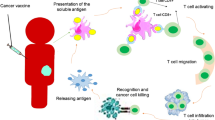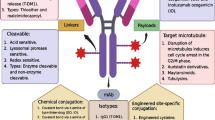Summary
This report confirms our previous observation that IV inoculation of purified protein A causes regression of rat mammary adenocarcinomas. In treated tumors, we have obtained histological evidence of changes indicating tumor cell destruction. Protein A treatment does not cause reduction in the body weight or organ weights of rats; nor does it cause any decrease in activity of the enzymes of the microsomal mixed function oxidase system in the liver. Protein A stimulates peripheral white cell counts in normal rats, but not in tumor-bearing rats. We found that protein A infusion reduced (P<0.0005) the level of circulating plasma immune complex concentration. A homing study with 125I-labeled protein A indicated that liver, spleen, and kidney tissues are the major sites of protein A accumulation. Therefore, protein A seemed to exert its antitumor effects without causing any generalized toxicity to the system. It is postulated that the action of protein A may be related to its ability to cause a drastic reduction in circulating plasma immune complex concentration, thus potentiating the immune reactivity of the host observed earlier.
Similar content being viewed by others
References
Baldwin RW, Price MR, Robbins RA (1972) Blocking of lymphocyte-mediated cytotoxicity for rat hepatoma cells by specific antigen-antibody complexes. Nature 238:185–187
Bansal SC, Bansal BR, Thomas HL et al. (1978) Ex vivo removal of serum IgG in a patient with colon carcinoma: some biochemical, immunological and histological observations. Cancer 42:1–8
Bensinger WI, Kinet JP, Hennen G et al. (1981) Plasma perfused over immobilized protein A for breast cancer. N Engl J Med 306:935–936
Berrigan MJ, Gurtoo HL, Sharma SD, Struck RF, Marinello AJ (1980) Protection by N-acetyl systein of cyclophosphamide metabolism-related in vivo depression of mixed function oxygenase activity and in vitro denaturation of cytochrome P-450. Biochem Biophys Res Commun 93:797–803
Catalona WJ, Ratliff TL, McCool RE (1981) Interferon induced by S. aureus protein A augments natural killing and ADCC. Nature 291:77–79
Cowan FM, Klein DL, Armstrong GR, Pearson JW (1979) Augmentation and inhibition of delayed hypersensitivity by Staphylococcus aureus Protein A. Biomedicine 30:241–246
Digeon M, Laver M, Riza J, Bach JF (1977) Detection of circulatory immune complexes in human sera by simplified assays with polyethylene glycol. J Immunol Methods 16:165–183
Gershon RK, Mokyr MB, Mitchell MS (1974) Activation of suppressor T cells by tumor cells and specific antibody. Nature 250:594–596
Gordon BR, Matus RE, Saal SD et al. (1983) Protein A-independent tumoricidal responses in dogs after extracorporeal perfusion of plasma over Staphylococcus aureus. JNCI 70:1127–1133
Gurtoo HL, Gessner T, Culliton J (1976) Studies of the effects of cyclophosphamide vincristine and prednisone on some hepatic oxidations and conjugations. Cancer Treat Rep 60:1285–1294
Hellstrom KE, Hellstrom I (1974) Lymphocyte-mediated cytotoxicity and blocking serum activity to tumor antigens. Adv Immunol 18:209–277
Hellstrom KE, Hellstrom I (1981) Does perfusion with treated plasma cure cancer? N Engl J Med 305:1215–1216
Herberman RB (1974) Cell mediated immunity to tumor cells. Adv Cancer Res 19:207–263
Holohan TV, Philip TM, Bowles C et al. (1982) Regression of canine mammary carcinoma after immunoadsorption therapy. Cancer Res 42:3663–3668
Jones FR, Yoshida LH, Ladiges WC et al. (1980) Treatment of feline leukemia and reversal of FeLV by ex vivo removal of IgG: a preliminary report. Cancer 46:675–684
Kerbel RS, Davies AJS (1974) The possible biological significance of Fc receptors on mammalian lymphocytes and tumor cells. Cell 3:105–112
Kronvall G, Gewurz J (1970) Activation and inhibition of IgG-mediated complement fixation by staphylococcal protein A. Clin Exp Immunol 7:211–220
Lowry OH, Rorebrough NJ, Farr AL, Randall RJ (1951) Protein measurement with the Folin phenol reagent. J Biol Chem 193:265–275
Messerschmidt GL, Wowles C, Alsaker R et al. (1983) Prognostic indicators of tumor response to Staphylococcus aureus Cowan strain I plasma perfusion. JNCI 71:535–538
Nebert DN, Gelboin HV (1968) Substrate-inducible microsomal aryl hydroxylase in mammalian cell culture. 1. Assay and properties of induced enzyme. J Biol Chem 243:6242–6249
Ray PK (1982) Suppressor control as a modality of cancer treatment: Perspectives and prospects in the immunotherapy of malignant disease. Plasma Therapy Transfusion Technology 3:101–121
Ray PK, Bandyopadhyay S (1982) Plasma elution of biomolecules from nonviable Staphylococcus aureus Cowan I. Fed Am Soc Exp Biol 41:556
Ray PK, Bandyopadhyay S (1983) Inhibition of rat mammary tumor growth by purified protein A — a potential anti-tumor agent. Immunol Commun 12:453–464
Ray PK, Idiculla A, Mark R et al. (1982) Extracorporeal immunoadsorption of plasma from a metastatic colon carcinoma patient by protein A-containing Staphylococcus aureus: clinical, biochemical, serological, and histological evaluation of the patients response. Cancer 49:1800–1809
Ray PK, Raychadhuri S, Allen P (1982) Mechanisms of regression of mammary adenocarcinomas in rats following plasma adsorption over protein A-containing Staphylococcus aureus. Cancer Res 42:4970–4974
Sakane T, Green I (1978) Protein A from Staphylococcus aureus — a mitogen for human T lymphocytes and B lymphocytes but not L lymphocytes. J Immunol 120:302–311
Siag WM, Jones JM (1982) Alteration by protein A of the distribution of immune complexes containing antigen of vitro-virus. Clin Immunol Immunopathol 24:186–193
Sjogren JO, Hellstrom I, Bansal SC et al. (1978) Suggestive evidence that the blocking antibodies of tumor bearing individuals may be antigen — antibody complexes. Proc Natl Acad Sci USA 63:1372–1375
Steele G Jr, Ankerest J, Sjogren JO (1974) Alteration in in vitro anti-tumor activity of tumor-bearer sera by absorption with Staphylococcus aureus Cowan I. Int J Cancer 14:83–92
Terman DS, Yamamoto T, Mattioli M et al. (1980) Extensive necrosis of spontaneous canine mammary adenocarcinomas after extracorporeal perfusion over Staphylococcus aureus Cowan I: description of acute tumoricidal response — morphologic, histologic, immunohistochemical, immunologic and serologic findings. J Immunol 112:795–805
Terman DS, Yamamoto T, Tillquist RL et al. (1980) Tumoricidal response induced by cytosine arabinoside after plasma perfusion over protein A. Science 209:1257–1259
Terman DS, Young JB, Shearer WT et al. (1981) Preliminary observations of the effect on breast adenocarcinoma of plasma perfused over immobilized protein A. N Engl J Med 305:1195–1200
Author information
Authors and Affiliations
Rights and permissions
About this article
Cite this article
Ray, P.K., Bandyopadhyay, S., Dohadwala, M. et al. Antitumor activity with nontoxic doses of protein A. Cancer Immunol Immunother 18, 29–34 (1984). https://doi.org/10.1007/BF00205396
Received:
Accepted:
Issue Date:
DOI: https://doi.org/10.1007/BF00205396




